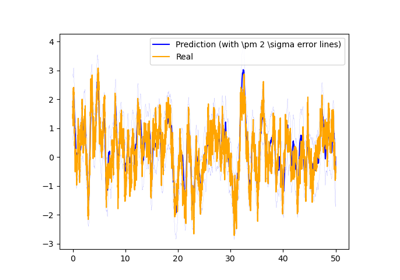GLE_analysisEM.GLE_Estimator¶
- class GLE_analysisEM.GLE_Estimator(dim_x=1, dim_h=1, tol=1e-05, max_iter=100, OptimizeForce=True, OptimizeDiffusion=True, init_params='random', model='euler', basis=GLE_BasisTransform(), A_init=None, C_init=None, force_init=None, mu_init=None, sig_init=None, n_init=1, random_state=None, warm_start=False, no_stop=False, verbose=0, verbose_interval=10, multiprocessing=1)[source]¶
A GLE estimator based on Expectation-Maximation algorithm.
- Parameters
- dim_xint, default=1
The number of visible dimensions
- dim_hint, default=1
The number of hidden dimensions
- tolfloat, defaults to 1e-5.
The convergence threshold. EM iterations will stop when the lower bound average gain is below this threshold.
- max_iter: int, default=100
The maximum number of EM iterations
- OptimizeForce: bool, default=True
Optimize or not the force coefficients, to be set to False if the force or the potential have been externally determined
- OptimizeDiffusion: bool, default=True
Optimize or not the diffusion coefficients
- init_params{‘user’,’random’,’markov’}, defaults to ‘random’.
The method used to initialize the fitting coefficients. Must be one of:
'user' : coefficients are initialized at values provided by the user 'random' : coefficients are initialized randomly. 'markov' : coefficients are initialized with Markovian estimation of the visible part
- model{}, default to ‘euler’.
Choice of time discretized model to be fitted. For now only euler model is implemented
- basis: a scikit-learn Transformer class, default to linear basis.
Transformer to get value of the basis function
- A_init, C_init, force_init, mu_init, sig_init: array, optional
The user-provided initial coefficients, defaults to None. If it None, coefficients are initialized using the init_params method.
- n_initint, defaults to 1.
The number of initializations to perform. The best results are kept.
- no_stop: bool, default to False
Does not stop the iterations if the algorithm have converged
- warm_startbool, default to False.
If ‘warm_start’ is True, the solution of the last fitting is used as initialization for the next call of fit(). This can speed up convergence when fit is called several times on similar problems.
- random_stateint, RandomState instance or None, optional (default=None)
Controls the random seed given to the method chosen to initialize the parameters (see init_params). In addition, it controls the generation of random samples from the fitted distribution (see the method sample). Pass an int for reproducible output across multiple function calls. See Glossary.
- verboseint, default to 0.
Enable verbose output. If 1 then it prints the current initialization and each iteration step. If greater than 1 then it prints also the log probability and the time needed for each step.
- verbose_intervalint, default to 10.
Number of iteration done before the next print.
- multiprocessing: int, default to 1
Number of process to use for E step
- __init__(dim_x=1, dim_h=1, tol=1e-05, max_iter=100, OptimizeForce=True, OptimizeDiffusion=True, init_params='random', model='euler', basis=GLE_BasisTransform(), A_init=None, C_init=None, force_init=None, mu_init=None, sig_init=None, n_init=1, random_state=None, warm_start=False, no_stop=False, verbose=0, verbose_interval=10, multiprocessing=1)[source]¶






